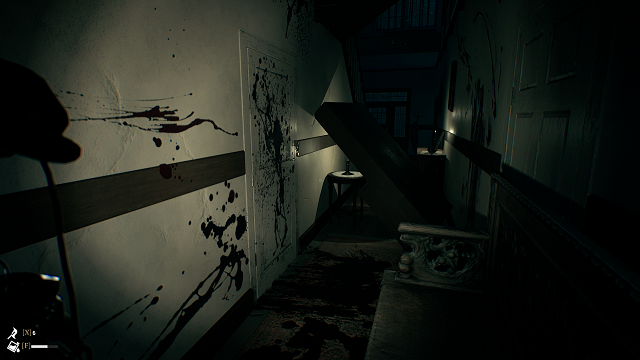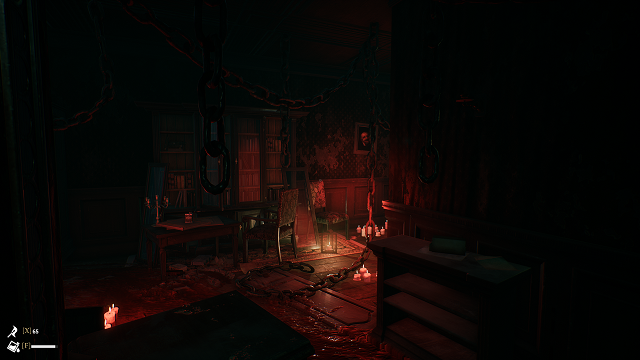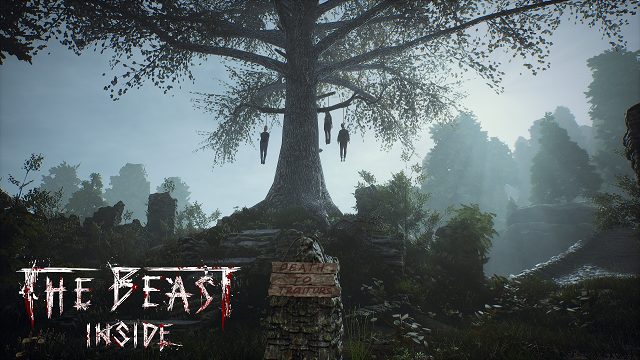In horror games old and new, the theory of good and evil warring within us acts as both catalyst and crutch. Stories are propelled by it, while characters are often crippled by it.
The easiest way to manifest duality in a visual medium is to incorporate a physical, horrific conjuration that rends flesh into the unimaginable. Unsurprisingly, that mechanism is often something as simplistic and primal as “the beast.”
Indeed, such an elementary metaphor does not equate to narrative imprecision. Films such as An American Werewolf in London deftly combine this thought into gripping, and at times humorous, displays of our primordial natures. Stories as timeless as Dr. Jekyll and Mr. Hyde embrace it with totality.
However, I struggle to name a horror game that does it as well as those terrifying standards. The Beast Inside seeks to overcome such a wide-ranging statement. Though, in seeking, it falters under the burden of its own polarity.
The Beast Inside Review: A Tale of Two Dueling Stories

The Beast Inside tells the story of two men across two very different timelines. Nicolas Hyde seeks to unravel the mysteries of his abusive childhood, retracing his father’s footsteps in the final years of the American Civil War. Adam Stevenson seeks to unravel the mysteries of Russian spies and his dual nature during the monomania of the Cold War.
These stories play out in alternating chapters, acting as imprecise mirrors of each other. In form and function, they could stand alone as games unto themselves.
Indeed, the demarcation between the two stories is a stark one. Held together by a fragile throughline and the parallel setting of Blackstone, Massachusetts, the alternating chapters could very well be prequels and sequels of each other. As they stand, chapter shifts between the two are often jarring. Separated into different games, they would compliment each other more than they do in their current form.
The game begins with Adam Stevenson, a CIA cryptanalyst. He’s moved to Blackstone with his pregnant wife, Emma, seeking the solitude and peace of the countryside. Bordering on a psychological collapse that’s merely hinted at in the opening chapters, Adam’s other reason for coming to Blackstone is to crack a Soviet code, sending his storyline down a path of pedantic era paranoia.
As a cryptanalyst, it’s not surprising that Adam’s chapters deal with puzzles and code-cracking. Interestingly, though, these puzzles are often few and far between, with only a small handful showing up throughout the game. Some are thoughtfully designed, such as the first chapter’s attic puzzle and the enigma puzzle that comes later. Others are simple memorization and deductive reasoning.
Most of Adam’s gameplay, though, is retracing the steps of Nicolas Hyde, his new home’s former owner. As story elements grow murkier and more “ghostly,” Adam gains access to a completely immersion-breaking tool: The Localizer.
It’s a contrivance purely based on science-fiction tropes. It adds to The Beast Inside a more active gameplay element than solving puzzles and walking around the Blackstone forest. I commend PlayWay for trying something “interesting” here, but the device feels completely out of place in the gritty, more realistic setting the game seeks to portray.
It doesn’t help that The Localizer beeps and boops with irritating abandon as you walk around looking for what amounts to ectoplasm. There’s even a shooter element introduced alongside the device, forcing players to hunt down anomalies and zap them with The Localizer’s EMP charges.
In many ways, The Localizer seems to exist only to give Adam something else to do — and to act as a balance to Nicolas’ chapters, in which Nicolas is able to wield a gun.

Between Adam’s chapters, you take the role of Nicolas Hyde. Though the nature of his referential name should not be lost on players, his past is clouded and murky, full of potentiality. In the game’s second chapter, he comes home to the Blackstone estate to uncover the secrets of his childhood, and the abuse he suffered at the hands of his father.
It is here, in Nicolas’ chapters, that The Beast Inside roars loudest. Whereas there is little to no horror in Adam’s chapters, Nicolas is plagued by terrifyingly macabre images of death and sadism. Physical and supernatural forces work to defeat Nicolas and keep him from uncovering the truth about himself and his father. There be ghouls and ghosts here, each more unsettling than the last.
In comparison to Adam’s chapters, the chapters in which you control Nicolas feel more complete and realized. Though they increasingly succumb to genre tropes — such as hiding from overpowered and impervious enemies — these chapters feel truer to what I believe was the original plan for The Beast Inside.
Portrayed as a photo-realistic horror game by its marketing materials and Kickstarter copy, The Beast Inside excels in these dark, brooding moments. The game’s most interesting and gripping concepts come as Nicolas slowly unravels his story and descends into the grip of madness.
Further complicating the dichotomy of The Beast Inside, Nicolas’ chapters include boss fights, (iffy) gunplay, and copious supernatural elements. These chapters also introduce the game’s survival-horror elements, where Nicolas must horde resources such as matches and lantern oil to light his path through what seems like perpetual darkness.
It’s too bad, then, that The Beast Inside isn’t all that dark. Sure, you can easily lower your monitor’s brightness settings, but the game isn’t as inherently abyssal as it should be. It’s a small gripe, but one that looms large considering the reliance on darkness during these chapters.
That being said, The Beast Inside is an utterly gorgeous game. It is perhaps the most beautiful horror game I’ve ever played. Though some character models should go back to the drawing board, an early revenant petrifies in both its movement and design. No matter how many times I play The Beast Inside, that one model terrifies me over and over again.
Environments, too, are both bucolic and hellish. Colors pop and water shines. Flames dance in the darkness like pirouetting demons, realistically illuminating their surroundings while leaving those just beyond their touch accurately stygian.
On top of that, the game’s sound design is mostly top-notch. There are moments where certain sounds aren’t mixed correctly, with some lower tones booming over those that ought to be louder. But on the whole, the game’s voice work, soundtrack, and sound effects work in concert to create a horrifying concerto.
The Beast Inside Review — The Bottom Line

Pros:
- Terrifying early chapters
- Gorgeous landscapes
- Mostly well-done sound design
- Morbid, horrifying imagery
- Several interesting puzzles
Cons:
- Story mostly misses its landing
- Pedantic portrayal of some characters, like Emma
- Increasingly jarring chapter shifts
- Anachronistic sci-fi elements
- Improperly mixed sound in some sections
For as much as I like The Beast Inside, it is a horror game that embodies the theory of duality in a flawed design. Starting out with sound and fury, it gradually subsides into well-trodden territory by its climax.
That is not to say The Beast Inside is not scary or well-done in some respects. Merely, it means that we’ve seen this before. Add to that fewer and fewer true scares — or even jump scares — as the game goes on, and you’re left with a psychological romp that doesn’t break new ground.
In most ways, The Beast Inside would have been stronger had it stuck to Nicolas’ story from start to finish. Adam’s character feels like nothing more than shoehorned plot device meant to adhere to the Jekyll and Hyde trope.
Perhaps I’m being a touch hard on the game, but it’s opening chapters are so well developed and paced that those coming after often feel overwrought. Here, such a dual structure undermines the core gameplay loop and overall narrative structure.
When The Beast Inside shines, it does so brilliantly. But just as a candle in the dark can only burn so bright, this is a game surrounded by encroaching darkness.
[Note: A copy of The Beast Inside was provided by PlayWay for the purpose of this review.]










Published: Dec 5, 2019 02:40 pm